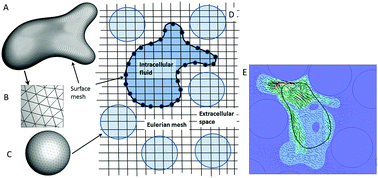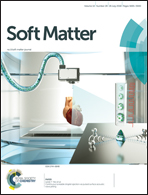A computational model of amoeboid cell motility in the presence of obstacles†
Abstract
Locomotion of amoeboid cells is mediated by finger-like protrusions of the cell body, known as pseudopods, which grow, bifurcate, and retract in a dynamic fashion. Pseudopods are the primary mode of locomotion for many cells within the human body, such as leukocytes, embryonic cells, and metastatic cancer cells. Amoeboid motility is a complex and multiscale process, which involves bio-molecular reactions, cell deformation, and cytoplasmic and extracellular fluid motion. Additionally, cells within the human body are subject to a confined 3D environment known as the extra-cellular matrix (ECM), which resembles a fluid-filled porous medium. In this article, we present a 3D, multiphysics computational approach coupling fluid mechanics, solid mechanics, and a pattern formation model to simulate locomotion of amoeboid cells through a porous matrix composed of a viscous fluid and an array of finite-sized spherical obstacles. The model combines reaction–diffusion of activator/inhibitors, extreme deformation of the cell, pseudopod dynamics, cytoplasmic and extracellular fluid motion, and fully resolved extracellular matrix. A surface finite-element method is used to obtain the cell deformation and activator/inhibitor concentrations, while the fluid motion is solved using a combined finite-volume and spectral method. The immersed-boundary methods are used to couple the cell deformation, obstacles, and fluid. The model is able to recreate squeezing and weaving motion of cells through the matrix. We study the influence of matrix porosity, obstacle size, and cell deformability on the motility behavior. It is found that below certain values of these parameters, cell motion is completely inhibited. Phase diagrams are presented depicting such motility limits. Interesting dynamics seen in the presence of obstacles but absent in unconfined medium, such as freezing or cell arrest, probing, doubling-back, and tug-of-war are predicted. Furthermore, persistent unidirectional motion of cells that is often observed in an unconfined medium is shown to be lost in presence of obstacles, and is attributed to an alteration of the pseudopod dynamics. The same mechanism, however, allows the cell to find a new direction to penetrate further into the matrix without being stuck in one place. The results and analysis presented here show a strong coupling between cell deformability and ECM properties, and provide new fluid mechanical insights on amoeboid motility in confined medium.



 Please wait while we load your content...
Please wait while we load your content...
